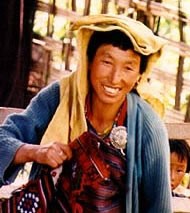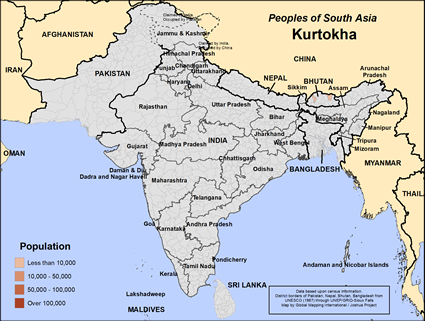Kurtokha in Bhutan

Photo Source:
Galen Frysinger
|

Map Source:
People Group Location: Omid. Other geography / data: GMI. Map Design: Joshua Project
|
| People Name: | Kurtokha |
| Country: | Bhutan |
| 10/40 Window: | Yes |
| Population: | 2,200 |
| World Population: | 2,200 |
| Primary Language: | Kurtokha |
| Primary Religion: | Buddhism |
| Christian Adherents: | 0.00 % |
| Evangelicals: | 0.00 % |
| Scripture: | Translation Started |
| Ministry Resources: | No |
| Jesus Film: | No |
| Audio Recordings: | Yes |
| People Cluster: | South Asia Buddhist |
| Affinity Bloc: | South Asian Peoples |
| Progress Level: |
|
Introduction / History
The Kurtop people inhabit areas of northern Bhutan, as far north as the border with China. Lhuntse District is home to the Kurtop. One scholar has given a detailed description of the extent of the Kurtop territory: 'Kurtop is a language of Lhuntse District spoken to the west of the mighty Kurichu [River] all the way to the Tibetan border in the north. The language is known to its speakers by the names Kurtokha and Kurt bi Zhak . It is an endangered language that will probably be gone in 100 years.
What Are Their Lives Like?
The Kurtokha homeland is in the isolated Lhuntse District. Lhuntse is famous in Bhutan for its weaving, embroidery and basket-making. There is no large-scale industry here, but many families earn their livelihood by weaving in their homes. Some earn their living by running food stalls and markets.
What Are Their Beliefs?
Tibetan Buddhism dominates the lives of all people in this part of Bhutan. Kurtokha families consider it to be a great honor to send their sons to the monastery for a time.
What Are Their Needs?
The name of Jesus Christ has rarely been heard in the remote Lhuntse valleys, and there are no known Christians among the Kurtokha people. We don t know of any Christ followers among the Kurtokha people of Bhutan.
Prayer Points
Pray for Kurtokha disciples to make many disciples.
Pray for the gospel to be embrace by Kurtokha family heads and taught to the children.
Pray for the Kurtokha people to understand and experience the power and goodness of God.